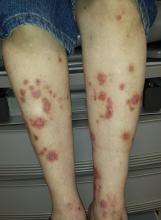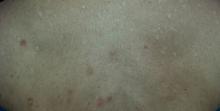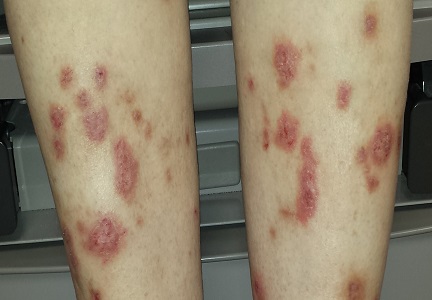User login
A 59-year-old woman presents urgently to dermatology for evaluation of very itchy lesions that manifested at least 20 years ago. They have been previously diagnosed as staph infection, fungal infection, psoriasis, and scabies but have not responded to a variety of topical steroid creams and topical antibacterials (eg, triple-antibiotic cream, mupirocin, and clindamycin solution). The patient has also been prescribed numerous oral antibiotics, the most recent of which was a 10-day course of clindamycin. This induced a raging case of diarrhea; her primary care provider subsequently referred her to dermatology.
She denies any family history of skin problems until her sister, who has accompanied her to this appointment, mentions that she and her mother have had similar problems for decades. More questioning reveals that all three women also have extensive psychiatric histories of chronic anxiety and depression.
When pressed, the patient and her sister admit to picking at their skin “constantly,” but especially when under stress.
EXAMINATION
Most of the patient’s lesions—round to oval, orangish red, scaly plaques that range from 2 to 5 cm—are on her legs, below her knees. There are about 15 lesions total. They look and feel very thick but have no increased warmth or tenderness. The erythema is confined to the lesions and does not extend into the surrounding areas.
Punch biopsy of one leg lesion shows a hypertrophic epidermis with focal parakeratosis, elongation of rete ridges, and perhaps most importantly, no signs of other items in the differential (such as psoriasis or skin cancer).
Elsewhere on her skin, extensive punctate disciform scarring extends across her upper back, stopping abruptly at the T2 level. The skin below remains totally clear.
What is the diagnosis?
DISCUSSION
The correct diagnosis is prurigo nodularis (PN), which was first described in 1909 and has been extensively studied since. Though much remains unknown about PN, we know that, typically, the patient plays a major role in the genesis and perpetuation of the condition. In other words, these patients are pickers—but as they’ll tell you, they “wouldn’t pick if the lesions didn’t itch.” It does appear that they have a much lower threshold for itching than the general population.
Personal and family history of serious, ongoing bouts of depression and anxiety, as seen in this patient, are also typical among PN patients. Women appear to be far more likely to be diagnosed with PN, though there is no documentation of this in the literature.
These observations, while helpful for diagnosis, still don’t fully explain exactly why one person has PN while another doesn’t.
Besides the biopsy results, other keys to distinguishing PN include the characteristic lesions themselves, as well as the sparing of sites out of the patient’s reach. As is often the case, multiple old scars were seen on this patient’s upper back, confirming the chronicity of the condition.
In addition to educating patients about their role in the creation and perpetuation of PN, I find the most useful treatment to be intralesional triamcinolone in a 10-mg/cc strength (1/4 cc stock triamcinolone diluted in ¾ cc lidocaine), delivered directly into the lesion by 30-gauge needle Alternatively, a class 1 topical steroid cream (eg, clobetasol 0.05%) can be applied twice daily and then covered with a bandage. In cooler weather, when patients tend to bundle up, additional layers of clothing help to create a barrier that prevents patients from picking as much.
New cases of “picking” suggest the possibility of other diagnoses, including renal or hepatic failure, occult cancer, or other skin disease (eg, mastocytosis).
TAKE-HOME LEARNING POINTS
• Prurigo nodularis (PN) often presents with multiple papules, nodules, and/or plaques that develop primarily as a result of picking, rubbing, or scratching the area.
• PN patients appear to have a lowered threshold for itching, which may play a role in their disease.
• The differential for PN includes squamous cell carcinoma, psoriasis, atypical mycobacteria infection, and metastatic cancer.
• Biopsy plays a key role in establishing the correct diagnosis.
• Intralesional steroid injection with 10 mg/cc triamcinolone stops the itching and shrinks the lesion.
A 59-year-old woman presents urgently to dermatology for evaluation of very itchy lesions that manifested at least 20 years ago. They have been previously diagnosed as staph infection, fungal infection, psoriasis, and scabies but have not responded to a variety of topical steroid creams and topical antibacterials (eg, triple-antibiotic cream, mupirocin, and clindamycin solution). The patient has also been prescribed numerous oral antibiotics, the most recent of which was a 10-day course of clindamycin. This induced a raging case of diarrhea; her primary care provider subsequently referred her to dermatology.
She denies any family history of skin problems until her sister, who has accompanied her to this appointment, mentions that she and her mother have had similar problems for decades. More questioning reveals that all three women also have extensive psychiatric histories of chronic anxiety and depression.
When pressed, the patient and her sister admit to picking at their skin “constantly,” but especially when under stress.
EXAMINATION
Most of the patient’s lesions—round to oval, orangish red, scaly plaques that range from 2 to 5 cm—are on her legs, below her knees. There are about 15 lesions total. They look and feel very thick but have no increased warmth or tenderness. The erythema is confined to the lesions and does not extend into the surrounding areas.
Punch biopsy of one leg lesion shows a hypertrophic epidermis with focal parakeratosis, elongation of rete ridges, and perhaps most importantly, no signs of other items in the differential (such as psoriasis or skin cancer).
Elsewhere on her skin, extensive punctate disciform scarring extends across her upper back, stopping abruptly at the T2 level. The skin below remains totally clear.
What is the diagnosis?
DISCUSSION
The correct diagnosis is prurigo nodularis (PN), which was first described in 1909 and has been extensively studied since. Though much remains unknown about PN, we know that, typically, the patient plays a major role in the genesis and perpetuation of the condition. In other words, these patients are pickers—but as they’ll tell you, they “wouldn’t pick if the lesions didn’t itch.” It does appear that they have a much lower threshold for itching than the general population.
Personal and family history of serious, ongoing bouts of depression and anxiety, as seen in this patient, are also typical among PN patients. Women appear to be far more likely to be diagnosed with PN, though there is no documentation of this in the literature.
These observations, while helpful for diagnosis, still don’t fully explain exactly why one person has PN while another doesn’t.
Besides the biopsy results, other keys to distinguishing PN include the characteristic lesions themselves, as well as the sparing of sites out of the patient’s reach. As is often the case, multiple old scars were seen on this patient’s upper back, confirming the chronicity of the condition.
In addition to educating patients about their role in the creation and perpetuation of PN, I find the most useful treatment to be intralesional triamcinolone in a 10-mg/cc strength (1/4 cc stock triamcinolone diluted in ¾ cc lidocaine), delivered directly into the lesion by 30-gauge needle Alternatively, a class 1 topical steroid cream (eg, clobetasol 0.05%) can be applied twice daily and then covered with a bandage. In cooler weather, when patients tend to bundle up, additional layers of clothing help to create a barrier that prevents patients from picking as much.
New cases of “picking” suggest the possibility of other diagnoses, including renal or hepatic failure, occult cancer, or other skin disease (eg, mastocytosis).
TAKE-HOME LEARNING POINTS
• Prurigo nodularis (PN) often presents with multiple papules, nodules, and/or plaques that develop primarily as a result of picking, rubbing, or scratching the area.
• PN patients appear to have a lowered threshold for itching, which may play a role in their disease.
• The differential for PN includes squamous cell carcinoma, psoriasis, atypical mycobacteria infection, and metastatic cancer.
• Biopsy plays a key role in establishing the correct diagnosis.
• Intralesional steroid injection with 10 mg/cc triamcinolone stops the itching and shrinks the lesion.
A 59-year-old woman presents urgently to dermatology for evaluation of very itchy lesions that manifested at least 20 years ago. They have been previously diagnosed as staph infection, fungal infection, psoriasis, and scabies but have not responded to a variety of topical steroid creams and topical antibacterials (eg, triple-antibiotic cream, mupirocin, and clindamycin solution). The patient has also been prescribed numerous oral antibiotics, the most recent of which was a 10-day course of clindamycin. This induced a raging case of diarrhea; her primary care provider subsequently referred her to dermatology.
She denies any family history of skin problems until her sister, who has accompanied her to this appointment, mentions that she and her mother have had similar problems for decades. More questioning reveals that all three women also have extensive psychiatric histories of chronic anxiety and depression.
When pressed, the patient and her sister admit to picking at their skin “constantly,” but especially when under stress.
EXAMINATION
Most of the patient’s lesions—round to oval, orangish red, scaly plaques that range from 2 to 5 cm—are on her legs, below her knees. There are about 15 lesions total. They look and feel very thick but have no increased warmth or tenderness. The erythema is confined to the lesions and does not extend into the surrounding areas.
Punch biopsy of one leg lesion shows a hypertrophic epidermis with focal parakeratosis, elongation of rete ridges, and perhaps most importantly, no signs of other items in the differential (such as psoriasis or skin cancer).
Elsewhere on her skin, extensive punctate disciform scarring extends across her upper back, stopping abruptly at the T2 level. The skin below remains totally clear.
What is the diagnosis?
DISCUSSION
The correct diagnosis is prurigo nodularis (PN), which was first described in 1909 and has been extensively studied since. Though much remains unknown about PN, we know that, typically, the patient plays a major role in the genesis and perpetuation of the condition. In other words, these patients are pickers—but as they’ll tell you, they “wouldn’t pick if the lesions didn’t itch.” It does appear that they have a much lower threshold for itching than the general population.
Personal and family history of serious, ongoing bouts of depression and anxiety, as seen in this patient, are also typical among PN patients. Women appear to be far more likely to be diagnosed with PN, though there is no documentation of this in the literature.
These observations, while helpful for diagnosis, still don’t fully explain exactly why one person has PN while another doesn’t.
Besides the biopsy results, other keys to distinguishing PN include the characteristic lesions themselves, as well as the sparing of sites out of the patient’s reach. As is often the case, multiple old scars were seen on this patient’s upper back, confirming the chronicity of the condition.
In addition to educating patients about their role in the creation and perpetuation of PN, I find the most useful treatment to be intralesional triamcinolone in a 10-mg/cc strength (1/4 cc stock triamcinolone diluted in ¾ cc lidocaine), delivered directly into the lesion by 30-gauge needle Alternatively, a class 1 topical steroid cream (eg, clobetasol 0.05%) can be applied twice daily and then covered with a bandage. In cooler weather, when patients tend to bundle up, additional layers of clothing help to create a barrier that prevents patients from picking as much.
New cases of “picking” suggest the possibility of other diagnoses, including renal or hepatic failure, occult cancer, or other skin disease (eg, mastocytosis).
TAKE-HOME LEARNING POINTS
• Prurigo nodularis (PN) often presents with multiple papules, nodules, and/or plaques that develop primarily as a result of picking, rubbing, or scratching the area.
• PN patients appear to have a lowered threshold for itching, which may play a role in their disease.
• The differential for PN includes squamous cell carcinoma, psoriasis, atypical mycobacteria infection, and metastatic cancer.
• Biopsy plays a key role in establishing the correct diagnosis.
• Intralesional steroid injection with 10 mg/cc triamcinolone stops the itching and shrinks the lesion.


